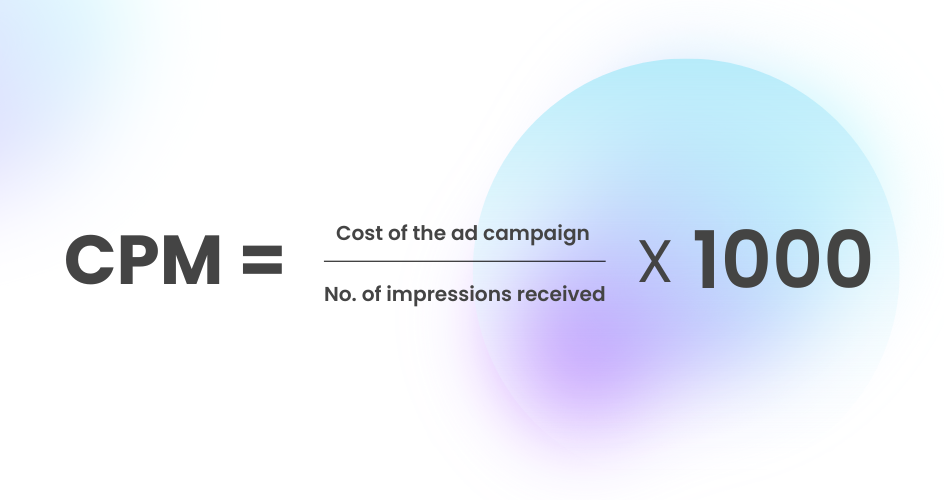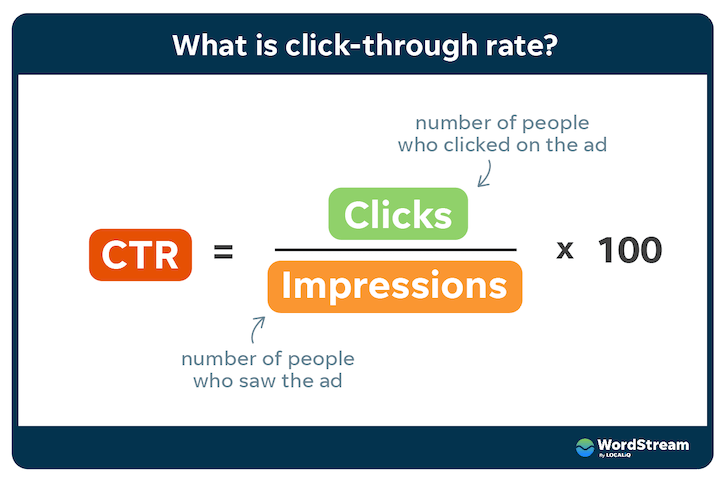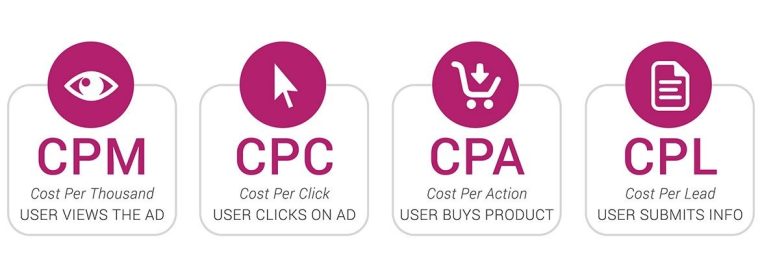Understanding the meaning of CPM is of utmost importance for digital marketers and content creators given the metric’s importance in day-to-day digital marketing efforts. In a nutshell, CPM stands for cost per mille or cost per thousand impressions and refers to the amount that an advertiser pays for every 1,000 impressions that their ad receives.
In this article, we’ll use our extensive knowledge and expertise in digital marketing to help you understand everything you need to know about CPM and its implications for online marketing campaigns.
Next, we will analyze the pros and cons of CPM marketing before diving into some of the other most popular methods of gauging web ads. Finally, we will look at some of the best ways to optimize your CPM strategy from the perspective of both marketers and affiliates.
CPM Meaning Explained
The “mille” in cost per mille is a Latin word that translates to thousands so CPM or cost per mille means cost per thousand impressions. It refers to the amount of money that advertisers pay for every 1,000 ad impressions generated on their advertisement (usually on a video or web page).
It is a unique metric in advertising because it only measures impressions and not clicks or conversions. Impressions and clicks are certainly correlated but click-through rates (a metric that measures the percentage of impressions that generate clicks) between mediums and affiliates can vary wildly.
CPM is one of many metrics used to measure the effectiveness of the advertising campaign as it helps to gauge the costs that companies pay to reach the intended audience.
Page Views vs. Impressions
While page views and impressions might sound similar, they are actually quite distinct. Page views refer to the number of times a webpage has been viewed, impressions on the other hand refers to the number of times a particular element – which can be an image, a video, or an advertisement – is viewed.
Page views are a key metric for websites and help them understand how many times visitors viewed their content. Impressions on the other hand help in gauging the views of a particular element. Ad impressions tell us how many times a particular advertisement has been viewed thus helping in gauging the effectiveness of the digital marketing strategies (along with other metrics like conversions).
How to Calculate CPM
The CPM formula is as follows:
CPM = (total ad spend)/(number of impressions) * 1,000
For instance, if the advertiser pays $200 for an ad campaign and it receives 20,000 impressions, the CPM rate would be as follows:
(200/20,000) x 1,000 = $10
Marketers need to have well-defined CPM strategies to reach their target audience in a cost-effective way and optimize the total cost. They also need to keep a close eye on other important metrics like click-through rates.
Don’t Forget About Click-Through Rate (CTR)
While the CPM rate tells us the cost per thousand impressions and helps us know the reach of the ad campaign, it doesn’t tell us how effective that ad is at attracting buyers or users. It’s also critical to know how many users click on the ad. This is where click-through rate (CTR) comes into the picture as it tells us what percentage of ad impressions converted into clicks.
For instance, a CTR of 5% tells us that only 5% of the viewers who saw the ad clicked on it to visit a website or landing page. The CTR tells the advertiser whether they are reaching the correct target audience and generally how effective the ad is at attracting people to their website or platform. If CTR is low you know that something needs to be optimized whether it’s the ad copy, the target audience, the affiliate, or something else.
Pros and Cons of the CPM Model
Using CPM to measure ad campaigns comes with both pros and cons when compared to performance-based pricing models like CPA (cost per action) and cost per click (CPC campaigns).
CPM Pros
- Can be cost-effective: CPM advertising campaigns often score above other ad campaigns in terms of cost-effectiveness because affiliates want the more secure option. They may know they can get impressions so they choose slightly lower pay rates in terms of CPM over click or conversion-based metrics for the security.
- Easy to implement and compare: It is easy to compare CPM marketing campaigns on different platforms.
- Helps build leads: A CPM advertising campaign helps in building leads for the advertiser.
- CPM campaigns help in building brand visibility: A good CPM advertising campaign helps in creating a buzz around the brand and helps in increasing visibility. CPM focuses only on sheer visibility so affiliates will push to get your ad as many impressions as possible.
CPM Cons
- Impressions might not lead to action: There is no surety on how many impressions would lead to action. It’s possible that you may pay hundreds of dollars or more on a CPM campaign and get nothing out of it if it fails to convert. Other metrics offer more secure pay structures for advertisers.
- Advertising fraud: Since the CPM pricing model is based on the number of impressions, it is possible that the sites where you advertise resort to outright fraud and use bots to generate impressions. It’s easier to fake impressions than it is to fake sales.
- Not reaching the target audience: In CPM campaigns, companies risk paying for impressions from outside of their target audience, essentially wasting money.
CPM vs CPC, CPA, CPL, CPQL: Ad Pricing Methods Discussed
Let’s now look at some of the common pricing models like CPC, CPA, CPL, and CPQL and then understand which pricing method helps best achieve the business goals and optimize the total ad spend.
- CPC or cost per click is an advertising revenue model based on the number of clicks that your ads generate. You pay for every click generated instead of just paying for impressions with CPM campaigns. This is often considered safer than CPM because it assures that you are paying for people actually visiting your page (assuming the clicks aren’t fraudulent) but it comes at a higher price.
- CPA or cost per acquisition or cost per action is yet another advertising revenue model similar to CPC but based on a final action and not just a click. Some of the actions that advertisers use in CPA models are a sale, an app install, or sometimes just the provision of contact info. This model is even more secure (and expensive) than the CPC model because it only measures the final desired action and not just impressions or clicks.
- CPL or cost per lead is another pricing model where the advertiser pays per lead. A lead is simply any individual or organization within their marketing reach who either has interacted with the brand (often to submit info like an email) or has the potential to become a customer in the future.
- CPQL or cost per qualified lead is an offshoot of CPL that requires the lead to fit one or more important categories. For example, many real estate investing platforms advertise for leads who are accredited investors. In this case, anyone not accredited who interacts with the ad wouldn’t count as a lead.
CPM Advertising: Which Model Suits Your Digital Marketing Strategy?
Marketers and affiliates need to consider affiliate marketing pricing models differently in order to see the most success. Here are quick guides for marketers and affiliates to follow when you aren’t sure which model to pick.
For Marketers:
All of these pricing methods have their pros and cons and fit into different digital advertising strategies. To choose the best model for your business you have to consider your specific situation and your goals. For instance, a CPM pricing structure may suit you best if your focus is to maximize impressions and generate a buzz around the business to increase brand awareness.
However, if the focus of your digital marketing strategy is to drive sales or app installs then a CPM model might not be your best choice.
If the advertiser can get the affiliate to agree to a reasonable CPC, CPA, or CPL, these would all likely be better models than CPM in this case. Nevertheless, CPM could still be best if you can secure a great rate with the right affiliates that you know will convert. As a rough rule of thumb, CPM rates are the cheapest followed by CPC, CPL, and CPA campaigns.
Remember that all of these rates will vary dramatically based on the platform and the partnered affiliate. For example, the average CPM for Google Search Ads is over 10 times higher than Google Display Ads according to epom.com.
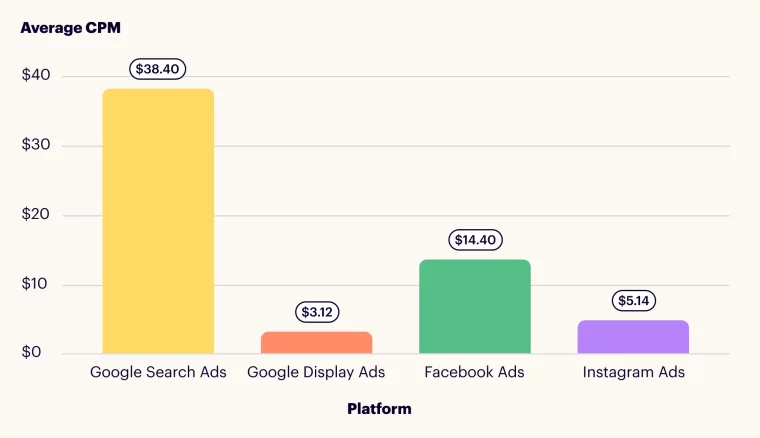
CPL and CPQL are often best when the intent is to generate leads that can be monetized over the long term. For instance, investing platforms looking for new users can run CPQL campaigns to target wealthy investors.
It’s also important to remember that even if you pick the best pricing model possible for your ad campaign, it won’t matter if the ad itself isn’t compelling or doesn’t reach the target audience.
For Affiliates and Content Creators:
For affiliates and content creators, CPM seems like it will always be the best strategy because it is generally easier to generate a ton of impressions than it is to generate clicks, leads, or actions. However, this isn’t always the case.
When you take the time to do the research and plan out your ad strategy, you may find that other performance-based models may be much more profitable than CPM. For example, if you run a cooking YouTube channel and a meal delivery service offers you a low CPM and a high CPA based on every sale made, the CPA model is probably best if you know that you can convert your viewers.
If you don’t think your ad will convert well, CPM may be the best choice for you. This doesn’t mean you should be lazy with an ad if you get a decent CPM offer, however. If your ad performs poorly that company will likely not offer you a deal next time.
Maximizing Returns With CPM for Marketers and Content Creators
There are multiple ways through which marketers and content creators/affiliates can maximize their CPM returns.
Maximizing CPM Returns for Marketers
The following strategies should help marketers maximize their CPM returns
- Use high-quality ad copy: Using high-quality ad copy is of utmost importance. If the ad fails to attract the attention of the user then the ad impressions might not convert into clicks. Also, for video ads, the initial few seconds should help build momentum and cajole the user to watch the full ad.
- Diversify your ads: You never know what ad would work with your target audience and hence it is important to diversify your ads.
- Monitor the ad frequency: Bombarding users with too many ads might not be among the best CPM strategies and apart from increasing the cost per thousand impressions it would also hurt the brand reputation and lead to ad fatigue
- Try different platforms and audiences: You can try putting the CPM advertisements across different platforms and audiences. It would especially hold true if you are advertising a new product.
Maximizing CPM Returns for Affiliates and Content Creators
Global affiliate marketing spending is expected to reach $14.3 billion in 2023 and rise further to $15.7 billion in 2024.
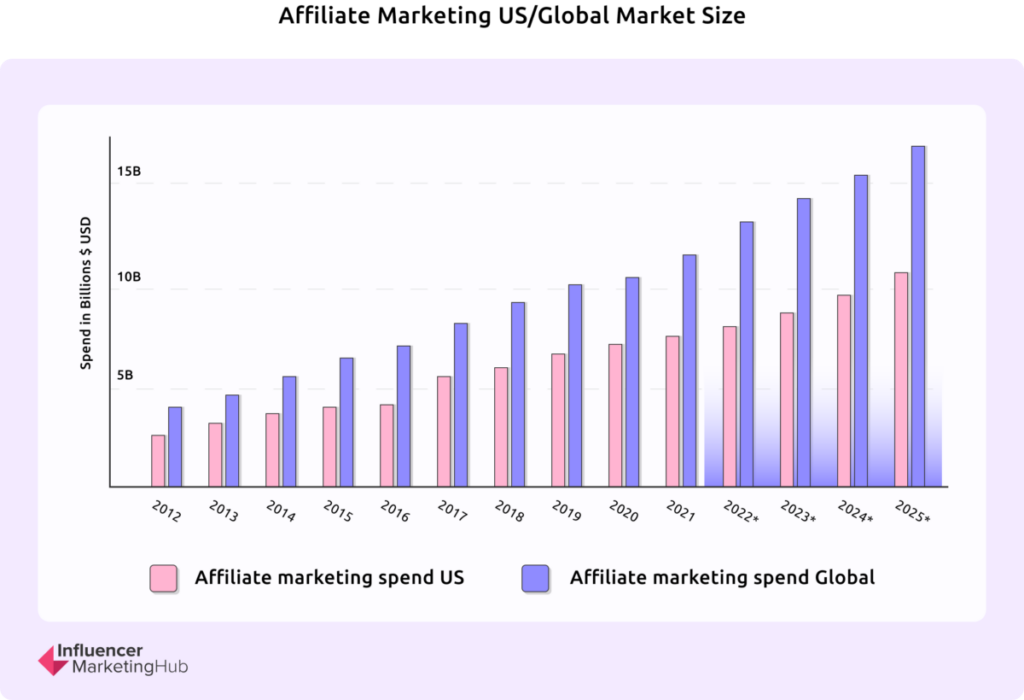
Here are a few steps that affiliates and content creators can use to optimize their CPM strategies to capture more of this massive market and increase their average CPM rates.
- Opt for the most profitable, relevant affiliate program: Simply picking the company with the best rates in your niche often works well, as long as it’s a quality partner that you don’t mind being associated with.
- Look for advertisers in high-margin industries: CPM rates vary drastically across industries and while investing platforms and online education have among the highest rates, food and electronics are stacked at the bottom. Make sure that you are still choosing an advertiser that your viewers may be interested in in some form or another.
- Create quality content and advertisements: Generally, the higher the quality of your content, whether it’s a highly optimized SEO blog or high-production value YouTube video, the more money you can make with advertising. Greater-quality content drives traffic and conversions better than poor-quality content.
- Keep ads organic and authentic: Don’t put your audience off by shoving in a random ad in an inopportune place or time in your content. Advertisers greatly prefer authentic, organically placed ads and will pay more for them.
Is a CPM Campaign Right for Your Business?
A CPM campaign is likely best for your business if the goal is to increase brand visibility and awareness and you reach a reasonable deal with your affiliates. New brands or companies launching entirely new products are often great candidates for CPM campaigns.
However, most marketers go beyond simple CPM campaigns and use various metrics and payment structures to make the most out of their budgets. It’s absolutely vital to analyze multiple metrics and optimize your marketing campaigns accordingly.

